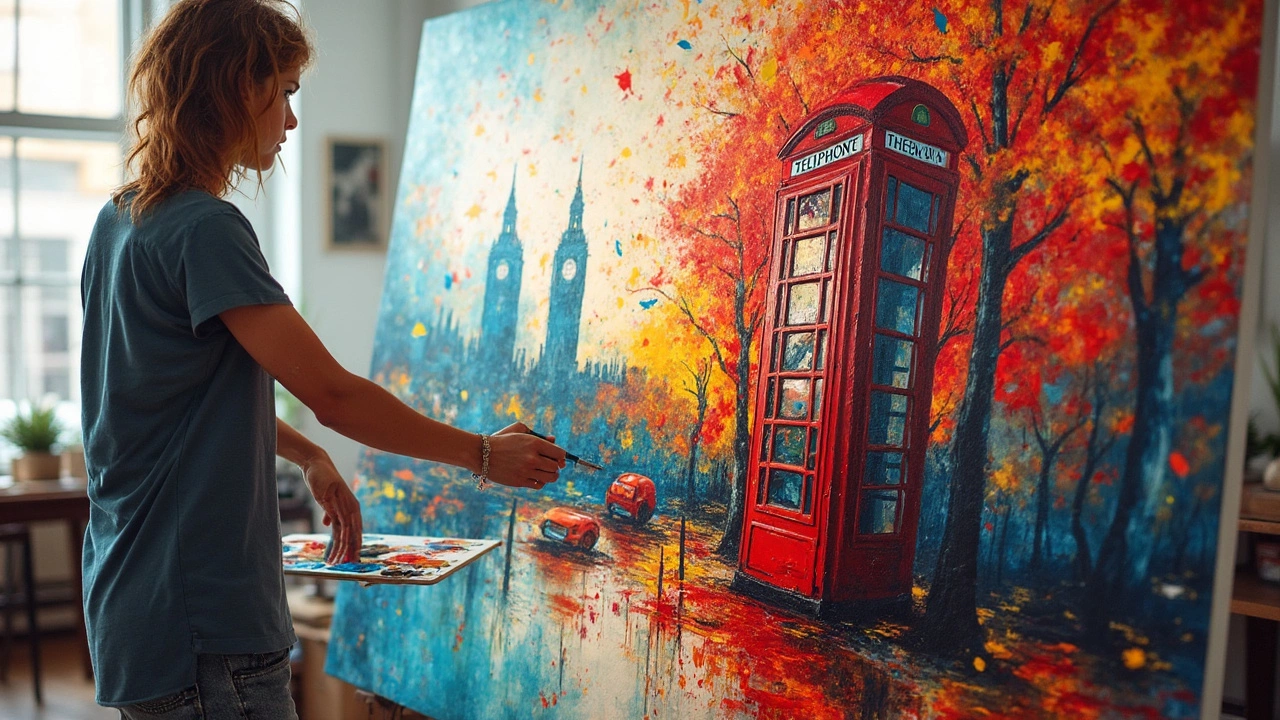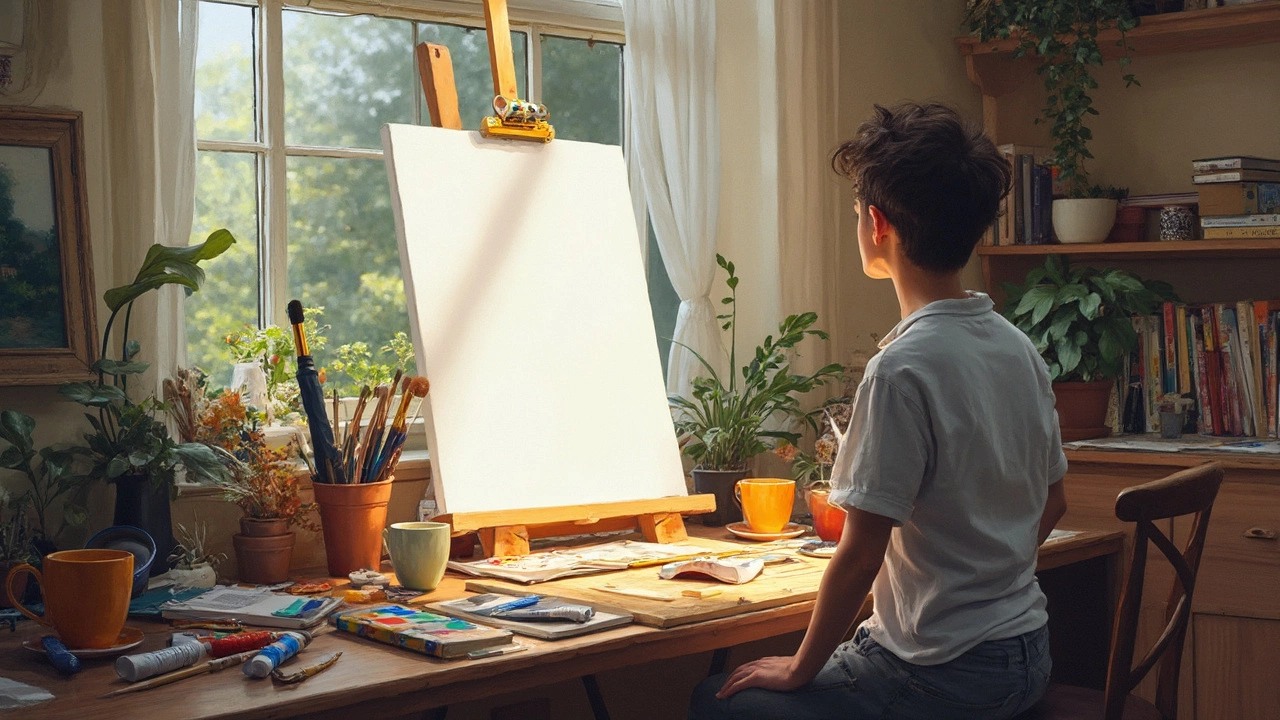Standing in front of a blank canvas feels weirdly intimidating, right? You might think you need years of art school or some mysterious talent before you start making abstract art. That’s not true. You can dive in with whatever you’ve got—even if that’s just spare paint and an old brush.
Forget rules. You’re not copying a bowl of fruit or a sunset here. Abstract painting is all about playing with color, texture, and shape, not about making stuff look ‘real.’ The truth? Most abstract artists start by experimenting—often by accident—until things suddenly click into place. There’s no secret club or official way to begin. The minute you start moving paint around, you’re already doing it right.
Here’s a tip that actually works: Don’t overthink. Pick a couple of colors you’re drawn to, slap them on the canvas, and see what happens. Sometimes the messiest beginnings turn into the most exciting pieces. And if it looks terrible at first? That’s normal—almost everyone’s first attempts do. The only thing you really need is a little willingness to look silly and try something new.
- Ditching Perfection: The Mindset Shift
- Gathering Tools Without Overthinking It
- Finding Inspiration in the Ordinary
- Simple Starter Techniques
- Embracing Mistakes and Happy Accidents
- Knowing When to Stop (And What Comes Next)
Ditching Perfection: The Mindset Shift
If you’re waiting to feel “ready” or searching for the perfect idea before you even start abstract painting, you’ll stay stuck at square one. A lot of people let that blank canvas make them freeze up, but the secret is: nobody’s perfect, and you’re allowed to make mistakes.
The whole point of abstract painting is that it’s not about perfect lines, flawless color matching, or even having a clear plan. Judy Chicago, a wildly influential contemporary artist, once said,
“Perfection is not as important as the act of doing, the process of making.”
This mindset can take a while to embrace, especially if you’ve always felt pressure to ‘get things right.’ Schools even found that focusing on process (rather than outcome) actually boosts creativity and makes people more likely to stick with art in the long run.
| Common Fears When Starting | Reality Check |
|---|---|
| What if I mess up? | Messing up is part of finding your style. |
| I don’t have a real technique. | Most abstract artists experiment first, then develop methods over time. |
| My art won’t mean anything. | Abstract art is often about feeling and process, not clear meaning. |
So, how do you actually let go of the need to be perfect? Here are a few practical tips:
- Try quick, timed doodles to loosen up—set a timer for just five minutes and make anything.
- Don’t erase or paint over everything you dislike. Sometimes a “mistake” is the start of something cool.
- Look up early works from your favorite abstract artists. Most of them look way different from their “famous” pieces.
Letting go of perfection is a skill, not a talent. The more you practice, the easier it gets. Remember, your first piece isn’t meant to hang in a gallery—it’s meant to get you started.
Gathering Tools Without Overthinking It
Trying abstract painting shouldn’t send you running to an art supply store with a giant list. The basics are super simple, and you don’t need the fanciest brands to start. Most artists agree: start small and upgrade later if you really want.
Here’s the deal—don’t sweat brands or super expensive tools. Stick to these essentials:
- Surface: Any canvas works. Even thick paper does the job. For beginners, a primed pre-stretched canvas saves headaches.
- Paints: Acrylic paints are easy to use, dry fast, and clean up with water. They’re the most popular for abstract work. Start with red, blue, yellow (your primaries), plus white and black for mixing.
- Brushes: A couple of wide flat brushes and one or two round ones are enough. If in doubt, cheap hardware store brushes can get some cool effects.
- Palette: Use a plastic plate, a piece of glass, or even some cardboard for mixing paint.
- Extras: Old credit cards, sponges, and your hands make fun marks too. Abstract painting loves weird tools—so raid your kitchen junk drawer.
Big fact: In a 2019 survey by Artfinder, about 66% of self-taught abstract artists said they started with cheap, store-brand supplies. What matters most is your willingness to experiment, not the price tag.
| Item | Recommended For Beginners? | Average Starter Price (USD) |
|---|---|---|
| Acrylic Paint Set (8 tubes) | Yes | $12–$20 |
| Pre-stretched Canvas (16"x20") | Yes | $6–$10 |
| Mixed Brushes (set) | Yes | $8–$15 |
| Palette (any type) | Yes | $2–$5 |
Famous abstract painter Helen Frankenthaler once said,
"You don't spend your life hanging around museums. You get what you can, and you use it."
That’s exactly it. Borrow, reuse, experiment. The best abstract work often comes from using what you already have lying around. Try different surfaces or swap paint brands as you go—nobody’s grading you here. Start with the basics and see what feels good in your hands. The art part comes from you, not your brush or paint label.
Finding Inspiration in the Ordinary
People hear "abstract painting" and think they need to search for deep meaning or wild ideas, but getting inspired is usually much simpler. Just look around—literally. Everyday stuff like shadows on the sidewalk, tangled wires, coffee stains, or the chaos inside your junk drawer can kickstart interesting abstract pieces. Famous painters like Jackson Pollock and Joan Miró took inspiration from random marks, city streets, or even their own messes before turning them into art.
If you’re stuck, try these go-to ways to mine your surroundings for ideas:
- Stare at textures—think tree bark, cracked paint, or peeling posters. Snap quick photos to use later for reference.
- Watch how sunlight or artificial light changes the look of your walls or tabletop, especially in the morning or evening.
- Zoom in on patterns in nature—blades of grass, paving stones, rain on a window. Up close, these tiny scenes can be way more interesting than a full landscape.
- Use music or sounds. Listen to your favorite song and move your brush as if you’re marking time with the beat—many abstract artists do this to loosen up.
You aren’t looking for things to copy, just prompts to help you break that blank-canvas freeze.
Numbers don’t lie—more than 60% of abstract artists in a 2023 Creative Arts Survey said their ideas usually came from ordinary routines, not big dramatic moments. Here’s a quick comparison:
| Source of Inspiration | Percentage of Artists |
|---|---|
| Everyday Life/Routine | 62% |
| Nature | 18% |
| Dreams/Imagination | 15% |
| Other Art | 5% |
The big trick? Be curious and observant. The more you notice, the more ideas pop up for your next abstract painting—no fancy tools required.

Simple Starter Techniques
Jumping into abstract painting doesn’t have to be complicated. You’ve probably seen abstract art that looks effortless—but there’s a little method behind the madness. Here’s what actually helps when you’re just starting out.
Start with basic supplies. Acrylic paint is the easiest for beginners: it dries fast, doesn’t smell weird, and is super forgiving if you mess up. Big brushes or even household items (think sponges, old credit cards, or even your fingers) are great for spreading paint in bold ways. Canvas panels or thick paper are cheap and good for practice.
If you’re wondering what to do first, here are a few techniques that work well for newbies:
- Layering: Paint one color, let it dry, then add another color on top. You can see cool effects where the top layer doesn’t cover the bottom layer completely. This is the easiest way to add depth.
- Dragging: Use a tool (palette knife, old card, plastic ruler) to drag paint across your surface. It makes interesting lines and textures with almost zero effort.
- Splatter: Dip your brush into watered-down paint and flick it onto the surface. Kids love it, pros use it, and you’ll get energetic results fast.
- Blotting: Press a sponge, paper towel, or even a crumpled plastic bag into wet paint. Lift off and see the surprise patterns it leaves behind.
If you want to break it down into steps, here’s a dead-simple way to start your first abstract painting:
- Pick 2-3 colors you like (don’t overthink it).
- Cover your canvas with one color (background layer).
- Add bold areas of your other colors, using your chosen technique (layering, dragging, etc).
- Try mixing a little white or black to play with light and contrast.
- Step back every few minutes to look at your work from a distance—this often helps you spot cool shapes or areas you want to add to.
You don’t need to plan everything. Some of the best-known abstract artists swore by letting the paint lead the way. Here’s a quick comparison of common beginner materials, so you know what to grab at the art store:
| Material | Why It’s Good | Avg. Price (USD) |
|---|---|---|
| Acrylic Paint | Dries fast, easy clean-up, good for layering | $1-3 per tube |
| Canvas Panel | Inexpensive, sturdy, won’t warp | $2-6 each |
| Sponge/Brush Set | Lets you test different effects | $5-10 per set |
The bottom line: try things, see what you like, and remember, your ‘mistakes’ might turn out to be your favorite parts.
Embracing Mistakes and Happy Accidents
If you start abstract painting expecting everything to go perfectly, you’ll probably get frustrated fast. The thing is, even professional artists mess up all the time—and that’s often how new styles or cool ideas are born. Jackson Pollock’s famous drip technique happened because he spilled paint and decided to roll with it. That messy splash? It turned into a whole artistic movement.
The pressure to make every brushstroke ‘mean something’ can kill your creative buzz. When something doesn’t turn out how you pictured, see if you can turn it into a feature. Maybe a weird splotch looks like energy in motion. Or a color that clashes could actually make your painting pop. Every "mistake" is a chance to try something different.
- Accidental smears? Try blending them with your fingers or a bit of water.
- Paint runs down the canvas? Tilt it to see what new patterns form.
- Colors look muddy? Layer over them or scratch into the wet paint for surprise textures.
Here’s a neat fact: according to a 2023 study by the Art Therapy Association, nearly 70% of beginner abstract artists said their favorite part of the process was seeing unexpected results. Those happy accidents can make your art feel unique and personal—even if it wasn’t what you meant to do.
| Mistake or Accident | Useful Trick |
|---|---|
| Unplanned drips | Let them dry, then layer new colors on top |
| Colors mix wrong | Use a palette knife to scrape and reveal new shapes |
| Smudge or streak | Add extra paint for texture or movement |
| Blank spot left | Fill it with bold marks or leave as intentional negative space |
So next time you make a splash or smear, don’t panic. In abstract painting, what looks like a screw-up now might be exactly what makes your work special in the end.
Knowing When to Stop (And What Comes Next)
It’s crazy how hard it can be to call a painting “done”—especially with abstract painting. There’s no checklist that tells you, “yep, you’re finished.” What most artists do is step back often, looking at the canvas from a distance, and even flipping it upside down or sideways. This makes your eye see things differently, and gaps or patterns jump out that weren’t obvious up close. If nothing major grabs your attention—like empty corners or colors fighting each other—you might actually be finished.
A lot of artists use the “gut check”: walk away from the painting, leave it for a day or two, and then look again. If you don’t feel the urge to add anything, that’s usually a sign it’s done. Another tip? Take a photo of your work and view it on your phone. Weirdly, it’s easier to spot if something’s off when it’s not staring at you life-size.
- Ask yourself: “Does this painting feel balanced, or does one area pull all the attention?”
- Would taking away or adding anything actually make it stronger?
- Do you enjoy looking at it for longer than a few seconds, or are you wishing you could cover it up?
Even the pros sometimes go too far—there’s a real stat for this. In a 2023 survey of working artists, about 62% said they’ve “overworked” a piece by accident, making it feel flat or muddy. Trust that little voice that says “stop here.” You can always add tomorrow; it’s harder to take things back.
| Method | Artists Who Use It |
|---|---|
| Stepping Away Before Finishing | 81% |
| Photo Review | 47% |
| Turning Canvas Upside Down | 39% |
So, what’s next after you finish? Protect your painting—a coat of varnish keeps colors bright and blocks dust. Snap good photos for your records. Show your work somewhere, even if it’s just posting it online. If you want, you can sign the back or front, but for abstract stuff, anywhere works. Most importantly, move onto the next one. Abstract art isn’t about chasing perfection; it’s about enjoying the crazy ride and seeing what you’ll discover next time.

